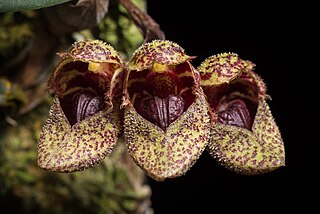
Bulbophyllum is a genus of mostly epiphytic and lithophytic orchids in the family Orchidaceae. It is the largest genus in the orchid family and one of the largest genera of flowering plants with more than 2,000 species, exceeded in number only by Astragalus. These orchids are found in diverse habitats throughout most of the warmer parts of the world including Africa, southern Asia, Latin America, the West Indies, and various islands in the Indian and Pacific Oceans. Orchids in this genus have thread-like or fibrous roots that creep over the surface of trees or rocks or hang from branches. The stem is divided into a rhizome and a pseudobulb, a feature that distinguished this genus from Dendrobium. There is usually only a single leaf at the top of the pseudobulb and from one to many flowers are arranged along an unbranched flowering stem that arises from the base of the pseudobulb. Several attempts have been made to separate Bulbophyllum into smaller genera, but most have not been accepted by the World Checklist of Selected Plant Families.

Bulbophyllum fletcherianum, the tongue orchid, Fletcher's bulbophyllum or Spies' bulbophyllum, is a rare orchid native to southern New Guinea. It prefers sunny rock outcrops or mossy tree branches, but besides being lithophytic or epiphytic, it can also be pseudo-terrestrial. The tongue orchid requires high humidity and moist roots.

Bulbophyllum frostii, commonly known as Frost's bulbophyllum or Dutchman's shoes is a species of orchid, In the wild it grows as an epiphyte, inhabiting evergreen seasonal lowland rainforests in Vietnam and more rarely in Thailand, including the Malay peninsula. It was more recently reported growing in the Yunnan province of China during a series of botanical surveys between 2017 and 2020. This plant is usually found at elevations of around 1500m above sea level.

Bulbophyllum fascinator is a species of flowering plant in the orchid family Orchidaceae, native to northeastern India, Southeast Asia, and northern Malesia. A pseudobulbous epiphyte found in lowlands, it can be confused with Bulbophyllum putidum.

Bulbophyllum umbellatum is a species of orchid. It is native to tropical parts of South Asia, from the west central Himalayas to Taiwan and Indo-China.
Bulbophyllum albidostylidium is a species of orchid in the genus Bulbophyllum found in Thailand.

Bulbophyllum cruciatum is a species of orchid in the genus Bulbophyllum found in Papua, Papua New Guinea, Seram Island, and Maluku Islands.
Bulbophyllum eublepharum is a species of orchid in the genus Bulbophyllum. Chromosome count is 2n = 38. Plants are epiphytes.

Bulbophyllum exiguum, commonly known as the tiny strand orchid, is a species of epiphytic or lithophytic orchid that is endemic to eastern Australia. It has small, roughly spherical pseudobulbs each with a single leaf and up to three small creamy white to yellow flowers emerging from the base of the pseudobulb. This orchid grows in rainforest and dry forest where it often covers the branches of trees or rocks on which it grows.
Bulbophyllum lichenoides is a species of orchid in the genus Bulbophyllum. This plant is non-poisonous. It is found in New Guinea on trees in range forests at elevations around 800 meters as a mini-miniature sized, warm growing epiphyte with barely noticeable, cylindrical pseudobulbs carrying a single, apical, patent, oblong, obtuse leaf that blooms in the late winter and early spring on an erect, short to 0.12" (3 mm) long, single flowered inflorescence.
Bulbophyllum maskeliyense is a species of orchid in the genus Bulbophyllum. Found in Sri Lanka and Southwest India, it is named after Maskeliya, a town in Sri Lanka.

Bulbophyllum plumatum is a species of orchid in the genus Bulbophyllum.

Bulbophyllum retusiusculum is a species of orchid in the genus Bulbophyllum.
Bulbophyllum vietnamense is a species of orchid in the genus Bulbophyllum found in Vietnam.
Bulbophyllum crabro, commonly called "Kam Pu Ma" in Thai, is a small orchid that grows as an epiphyte or is sometimes found as lithophyte. It grows in rainforests 1,600-2,000 m above sea level. It was formerly known as Monomeria barbata and was the type species of the genus Monomeria, now synonymous with Bulbophyllum. It is used in traditional Chinese medicine for treating coughs, pulmonary tuberculosis and trauma.

Bulbophyllum fenestratum is a species of orchid that is endemic to Southeast Asia. It is a small epiphyte with a single erect, egg-shaped leaf with the lower end towards the base, and seven to fifteen flowers about 10 mm (0.4 in) long on a peduncle 80–120 mm (3.1–4.7 in) long, each flower on a pedicel about the same length.
Bulbophyllum sect. Altisceptrum is a section of the genus Bulbophyllum.

Bulbophyllum sect. Peltopus is a section of the genus Bulbophyllum.
Bulbophyllum sect. Hymenobractea is a section of the genus Bulbophyllum.
Bulbophyllum sect. Piestobulbon is a section of the genus Bulbophyllum.











